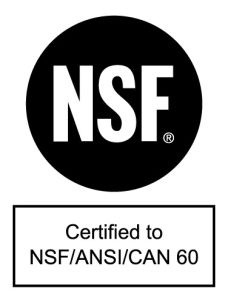Use DRY ACID to:
- remove clays, shales, drilled “cuttings” and commercial drilling muds from water wells. Excellent for “gravel-slipping” and freeing stuck drill pipe.
- develop new wells to their maximum specific capacity by breaking down mud-cake produced during drilling.
- redevelop old wells producing in sand and gravel formations to their original flow or greater.
How to use DRY ACID:

Use 1/2 to 3/4-lb. of DRY ACID per gallon of water in large diameter wells, and 3/4 to 1- lb. of DRY ACID per gallon of water is small diameter wells. (See table for calculation)
If a deep well turbine pump is in the hole, add about 1/4 the required amount of DRY ACID at a time between the pump column and casing. Agitate by backwashing after each addition of acid. If a rig is over the hole, add the acid inside the casing and agitate with a bailer, surge block or other tool.
If well is gravel-packed, displace the acid solution back through the gravel by surging or adding water equal to about 3/4 the volume of water standing in the hole. In new wells displacement should occur soon after all the acid has been thoroughly mixed. In old wells allow the acid to stay in the casing for about an hour or more before adding the water. Water should be added slowly.
DRY ACID should remain in the well for 24-36 hours and should be agitated every few hours. If a rig is over the hole agitate with a bailer, surge block or other tool. Dry ice can be used to agitate the chemical if rig or pump are not available.
Pump or bail the hole clean, and then test. Initial water after treatment contains spent chemicals and should be pumped to waste.
For additional chemical penetration use with Cotey Chemical’s MUD-NOX.
For best results agitate the solution in the well agressively with a tight-fitting surge block or the Cotey well cleaning brush.
How to dispose of DRY ACID:
Treatment with DRY ACID results in increased levels of sodium and bisulfate ions, depending on pH of the water. Thus, waste should not be pumped to cultivated fields as local reduced permeability and toxicity to plants may results. Waste should not be available to stock and should not be pumped to streams unless considerable dilution can be assured. Cotey therefore recommends that waste be pumped to sewage,barrow ditches for natural evaporation, or to local pits for evaporation and consequent filling provided infiltration will not contaminate a local aquifer. In all cases waste should be thoroughly diluted. (Local, State and Federal regulations should be adhered to.)
CAUTION:
DO NOT MIX DRY ACID WITH OTHER CHEMICALS!
DRY ACID is primarily an acid. Avoid breathing the dust and flush with water in case of contact. Wash after handling and use with adequate ventilation. If swallowed drink large quantities of fluid such as tea, coffee, water or, better yet, milk with raw eggs if available. Secure medical aid as quickly as possible.
DRY ACID is safe on plastics, rubber and metals commonly used in water well equipment. It will not harm the pump or well screen.
DRY ACID and all Cotey products are safe enough to use without pulling the pump.
DRY ACID is packaged in 10-lbs., 50-lbs., and 600-lbs. containers.

